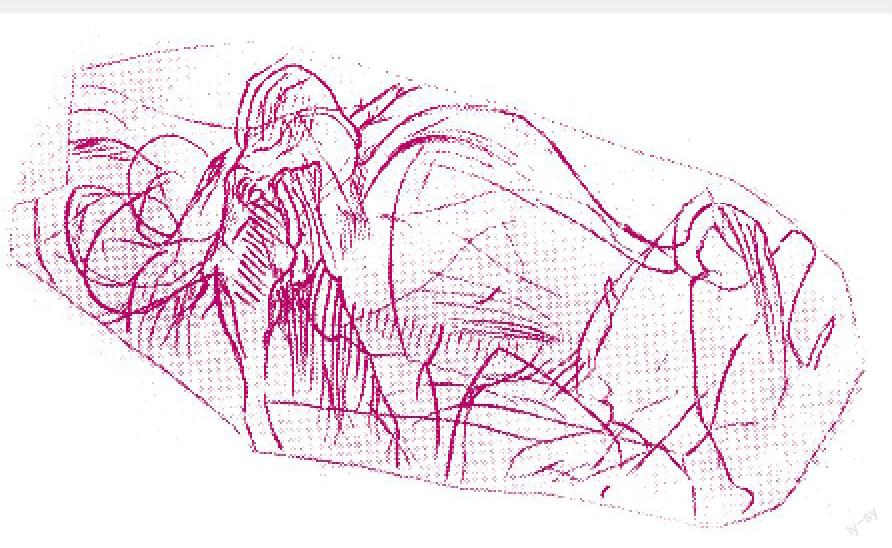The Oldest Pictures in the World (Ⅱ)世界上最古老的图画(下)
2022-05-30



Now, what do you suppose these cave men drew pictures of? Suppose I asked you to draw a picture of anything—just anything. Try it. What you have drawn is probably one of five things. A cat is my first guess, a sail-boat or an automobile is my second, a house is my third guess, a tree or a flower is my fourth, and a person is my fifth. Are there any other kinds?
你认为这些穴居人会画些什么呢?假如我让你随便画点什么,什么都可以,试想想看,你会画些什么呢?我想你画的东西应该不超出以下五种:猫是我第一个猜想,帆船或者汽车是第二个猜想,房子是第三个猜想。如果我还没有猜中的话,树或花是第四个猜想,而人是第五个猜想。除此之外,还有别的吗?
Well, the cave men drew pictures of only one kind of thing. Not men or women or trees or flowers or scenery. They drew chiefly pictures of animals. And what kind of animals, do you suppose? Dogs? No, not dogs. Horses? No, not horses. Lions? No, not lions. They were usually big animals and strange animals. But they were pretty well drawn, so that we know what the animals looked like. Here is a picture a cave man drew thousands of years ago.
事实上,穴居人只画一种东西。不是男人,不是女人,不是樹,不是花,也不是景色。他们画的主要是动物。那么你认为会是哪种动物呢?狗?不是的。马?也不是。狮子?还不是。他们画的动物通常很大,很奇怪。但是他们并没有乱画,相反,这些动物都画得很好,所以直到今天我们都可以看出它们的样子来。上图就是一张穴居人在几千年前画的图画。
You know its a picture of some animal, and its not a cat or a caterpillar. It is some animal of the kind they had in those days. It looks like an elephant and it was a kind of elephant—a huge elephant. But its ears were not big like our elephants ears and it had long hair. Elephants now have skin or hide, but hardly any hair. This animal we call a mammoth. It had long hair because the country was cold in those days and the hair kept the animal warm. And it was much, much bigger even than our elephants.
看得出这张图画画的是某种动物,而且这种动物不是猫也不是毛毛虫,这是一种真实存在于远古穴居人那个时代的动物。它看起来很像大象,事实上也是一种巨型象,但它的耳朵没有现在大象的耳朵长,而且它的毛发非常长。现在的大象虽然有兽皮,但几乎没有毛发。根据这个特征,我们将这种生活在远古时期的动物叫作长毛象。长毛象的毛发很长,因为那个时候地球的气候非常寒冷,长长的毛发可以保暖。另外,长毛象比现在的大象要大很多很多。
There are no mammoths alive now, but men have found their bones and they have put these bones together to form huge skeletons. We still call any very big thing “mammoth”. Youve probably heard of Mammoth Cave in Kentucky. It was called Mammoth, not because mammoths lived in it, because they didnt, but just because it is such a huge cave.
可惜现在已经没有存活的长毛象了。但是现代人找到了它们的骨头,并且将这些骨头拼接起来,组成了大型骨架。如今还有人把非常庞大的东西叫作“长毛象”。你可能听说过美国肯塔基州的长毛象洞,事实上那里以前从来没有长毛象居住过,这个洞之所以叫这个名字只是因为它非常大。
Word Study
chiefly /'t?i?fli/ adv.主要地;首要地
We are chiefly concerned with improving educational standards.
caterpillar /'k?t?p?l?(r)/ n.毛虫,蠋(蝴蝶或蛾的幼虫)
mammoth /'m?m?θ/ n.猛犸(象);毛象
adj.极其巨大的;庞大的
Thecavemendrewother animals besides the mammoth. One was the bison , a kind of buffalo . You can see a picture of a buffalo on our five-cent piece. It looks something like a bull. A little girl had gone to a cave in Spain with her father, who was searching for arrow-heads. While he was looking on the ground, she was looking at the ceiling of the cave and she saw what she thought was a herd of bulls painted there . She called out, “See the bulls!” and her father, thinking she had seen real bulls, cried, “Where? Where?”
除了长毛象,穴居人也画其他动物,包括美洲野牛,是水牛的一种。在美国的五分硬币上就能看到美洲野牛的样子,它看起来和公牛差不多。以前在西班牙,有一个小女孩跟着她的爸爸进了一个洞穴去找箭头玩。当她爸爸在地上寻找时,小女孩往洞的顶上望了一下,她发现洞顶上画着一些东西,看起来很像一群公牛。小女孩就叫道:“爸爸,快看,有公牛!”她爸爸以为女儿见到了真的公牛,大惊失色,慌忙叫着:“在哪?在哪?”
Other animals they drew were like those we have now—reindeer, deer with big antlers, and bears and wolves.
虽然长毛象灭绝了,但是其他的很多动物还存在,所以穴居人画的其他动物很多也跟今天的动物差不多,比如驯鹿、长角鹿、熊和狼。
It was quite dark in the caves where the cave men drew these pictures, for of course there were no windows, and the only light was a smoky flame from a kind of lamp. Why, then, did they make pictures at all? Such pictures couldnt have been just for wall decorations, like those you have on your walls, because it was so dark in the cave. We think the pictures were made just for good luck. Or perhaps they were to tell a story or make a record of some animal the cave man had killed. But perhaps the cave man just had to draw something, as boys and girls nowadays draw pictures on the walls of a shed or even sometimes on the walls of their own houses or, worse yet, on their desk tops.
穴居人在畫这些图画时,洞穴里非常暗。因为那时的洞穴肯定是没有窗户的,唯一的光线就是火把所发出的昏暗的光。那么,他们为什么要画这些画呢?这些图画绝不仅仅像你用来装饰墙壁的装饰画那么简单,因为那时候洞穴里很暗。我们认为那时的人们画这些画是为了祈求好运。当然,他们也可能是希望讲述一个故事,或者记录下他们宰杀的某种动物。不过要是让我猜,我就会觉得其实穴居人就是忍不住想画点什么,就像今天的孩子们一样,总是忍不住在车库墙上涂抹点东西,甚至有时候画在自家房子的墙上,又或者,画在了课桌上……
The pictures made by these wild men—bearded and hairy cave men— are the oldest pictures in the world, and the artists who made them have been dead thousands of years . Can you think of anything you might ever make that would last as long as that?
这些原始人——长须长头发的穴居人——他们所作的画是世界上最古老的图画,这些画的画家早在几千年前就去世了。你能想出有什么东西可以像这些图画一样保存这么长时间吗?
Word Study
bison /'ba?sn/ n.野牛(分北美野牛和欧洲野牛两类) buffalo /'b?f?l??/ n.水牛(分非洲水牛和亚洲水牛两种) herd /h??d/ n.兽群;牧群
lamp /l?mp/ n.灯;发热灯;照射灯
decoration /'dek?'re??n/ n.装饰;装饰风格;装饰品;勋章
